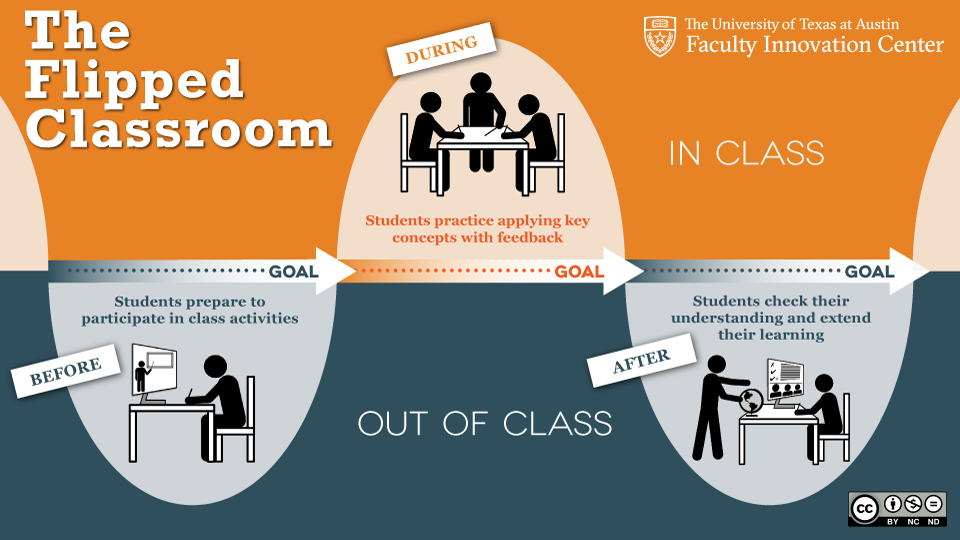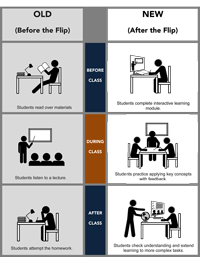This guide is designed to walk you through the steps of flipping a single class; the process is scalable for flipping portions of each unit or an entire course. One of the major factors in course redesign is the time it takes to do it well. We recommend pilot testing the flipped model with a single class before engaging in a complete redesign.
Step 1: Identify where the flipped classroom model makes the most sense for your course
The following questions may help you identify a good place to start, whether you have designed your course around learning outcomes or by units:
- In which class sessions do you currently have an in-class activity that you rarely have time to complete during class and requires the students to apply their knowledge and skills?
- What concepts or topics do students struggle the most to understand, based on exam scores and/or assignment grades?
- On what topics would students benefit from the opportunity to apply concepts under your expert guidance in the classroom?
UT instructors share how they adapted to the new roles they play within the classroom and helped students adjust to their new roles within the flipped class.
Step 2: Spend class time engaging students in application activities with feedback
The crux of the issue is figuring out for your class how class time could be repurposed in ways that provide students with an appropriate level of challenge while leveraging your expertise as a coach or guide. There are many possibilities for infusing a class with collaborative learning experiences. Utlimately, it comes down to finding an approach that works best for your students and your course content. Learn More
UT instructors share how they developed in-class engagement structures that leverages the power of the flipped class.
Step 3: Clarify connections between inside and outside of class learning
The point of the Flipped Learning model is to move the application-oriented "homework" into the classroom and to move the "lecture" to before class. Here are a few questions to get you started in this process:
- What do I want my students to know and be able to do as result of completing this sequence of the course? How does it fit into the bigger picture of the unit and course?
- What part of the current "homework assignment" could be moved inside of class to help students practice applying the content? What in-class learning activity is being rushed because there is currently not enough time to do it well?
- What practice do students need inside of class to prepare them for the larger assignment that will be completed after class? Will students make the connection between what is happening inside of class and the assignment they are working on after class?
- What content do students need to know before class to successfully engage in the learning activity during class?
The after-class portion may consist of a wide variety of activities including completing the work started in class or reading deeper about the topic or working together on a larger assignment that extends several class periods or practicing on one's own. Keep in mind that the after-class portion from the last class occurs at the same time as the before-class portion of the next class, so helping students manage the workload is important.
UT instructors share how their course learning outcomes helped them make connections between in-class and out-of-class engagement.
Step 4: Adapt your materials for students to acquire course content in preparation of class
The dynamic and active environment that is created within the flipped classroom, means that it is essential for students to come prepared for class. Once you have a clear idea of how students will be asked to apply their knowledge and skills during class, begin considering what students will need to read or view in advance. While online video content is associated with the Flipped classroom model, one can flip a class by repurposing traditional materials. Some common ways students prepare for class incude:
- Reading materials (e.g., textbook chapters or relevant articles)
- Online video and audio content (e.g., podcasts, videos, online micro-lectures, simulations, or demonstrations)
Keep it simple at first by either relying on your current resources or using existing online content rather than creating your own. If you have time, explore what content currently exists online that may help you supplement your resources. Whatever path you take, make sure that you:
- Hold students accountable for completing the pre-class assignment, and
- Provide students a way to pose questions about the content they are learning outside of class.
UT instructors explain how they developed structures for students to engage in course content before class by either creating their own materials or curating what already exists and placing it online.
Step 5: Extend learning beyond class through individual and collaborative practice
How will the content and skills learned before and during this class prepare students for extending their learning after class (e.g. finishing the problem set, starting work on a project or a portion of an assignment, building upon what was begun in class to delve deeper into the topic, practicing alone or collaborating with peers, etc.)?
Students gain experience applying course content during class time, but they may also need additional practice after class. Extending what happens inside the class to outside the class is a crucial step for students to gain mastery and meet the learning outcome. Some ideas for deepening student understanding include:
- Use discussion boards or academic social media to elaborate on ideas developed inside class.
- Present additional problems (on Canvas, course website, or from the textbook) for students to gain further practice on their own outside of class. Online assessment systems can be used to provide immediate feedback to students.
- Create assignments that require students to take the skills and knowledge developed in class and apply it in a new way or to a new situation not covered in class.
- Assign additional readings that further expands upon the concepts discussed in class.
- Encouarage students to create informal learning groups.
- Develop a peer-led undergraduate study where students come together once a week to work additional problems that expand upon the concepts being learned in class.
Contact us to request a consultation about how to flip your class to bring more active engagement and collaboration into your classroom.
Additional Resources
Whether you want to flip one class session or an entire course, the following questions will help guide you through the essentials.
This infographic shows a typical sequence of learning opportunities before, during, and after a flipped class.
This table shows the differences in the student experience of a traditional and flipped class.
Instructors who are flipping their class often describe the impact of this shift from the traditional classroom to the flipped classroom.



